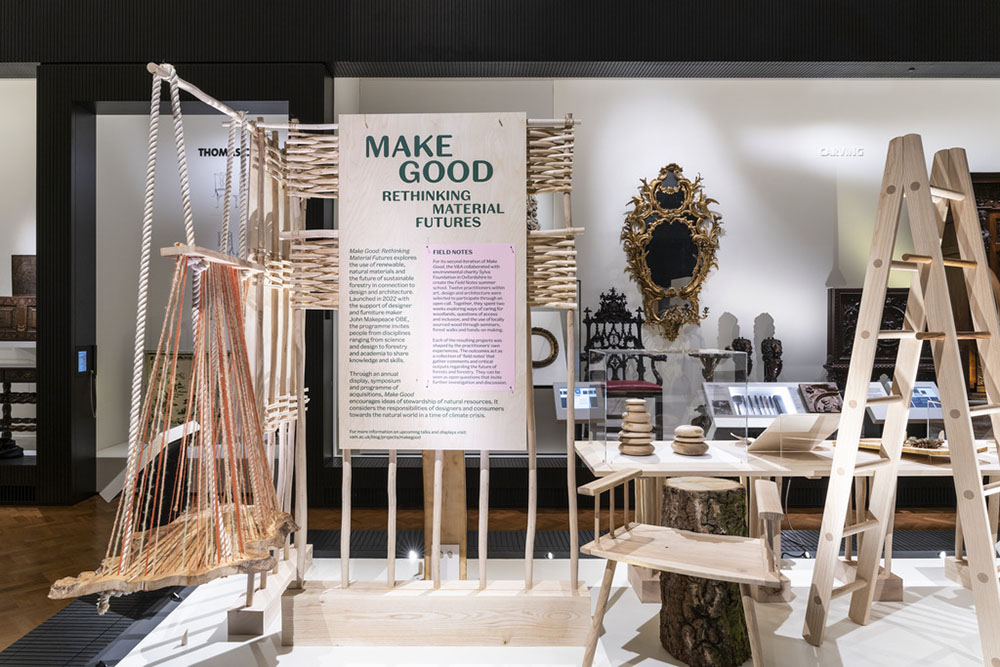Beatrix Bray is one of 12 people who participated in the Field Notes summer school, a programme co-organised by the V&A Make Good: Rethinking Material Futures programme in collaboration with the Sylva Foundation.

Bray is a designer and maker from Nottinghamshire who graduated from Sheffield Hallam’s Institute of Arts with a degree in furniture design in 2018. During her BA, her work became increasingly focused on the engagement between humans and objects and the power a designer wields in orchestrating this relationship. She was awarded the Consistent Academic Achievement accolade by the Chartered Society of Designers (2018) and was the runner-up in the John Lewis Loves category at New Designers, London (2018) where her low table ‘Fluctuare’ was exhibited. The design of the table, which features American walnut topped with a system of reconfigurable, hand-carved sycamore tiles, was influenced by her personal observations of a societal discontentment, a disconnectedness between people and their physical surroundings. As Bray comments, ‘as humans, we become so emotionally invested in our belongings, and I believe their ability to evolve alongside the user is key in establishing lasting, sustainable and continuously joyous material relationships. The retention of this emotional value in turn counteracts the disposability of an item – preserving resources – while simultaneously enriching the lives of those they surround.’
I wish to engage in, and help develop, the regeneration of our wood culture, both as a maker, but also for our society and for the environment as a whole.
Beatrix Bray
Bray’s making practice has continued to be centred on the idea of achieving harmony and balance, from the form of an object and the curation of the space it inhabits, to the use of sustainable, natural materials such as timber and willow. As she observes, ‘my designs look for balance not only between a piece’s form, function and materiality, but also its place within human lives, spaces and the wider ecological systems of which we are all party to and responsible for.’ Her project focused on food packaging disposability and our reliance on single use packaging addressed this issue and resulted in the design of a range of bowls that enrich the rituals of eating pre-prepared food on the move and demonstrated that utilitarian objects can be beautiful. As Beatrix observes, ‘consuming consciously does not have to mean compromise!’.
Bray joined the Field Notes summer school to deepen her understanding of sustainable forestry and timber production and collaborate with others in the vital conversation around makers and the sustainability of their materials. According to the Wood Recyclers’ Association, 450,000 tonnes of waste wood is generated each year in the UK. Bray’s response is to put this wasted material to good use, by turning vessels from sections of trees that are unsuitable for milling. In the future, she also hopes to process the shavings into paper.

Her narrative-based installation of balanced pebble forms created during the summer school is turned from the imperfect, split and knotty British offcuts of green ash, birch and elm. The nature of our relationship with woodland and the way in which we use the timber it provides, she believes, is in a state of unsustainable imbalance. In order to restore equilibrium, she proposes, we as a culture must nurture a reverence and heartfelt respect for our trees and forests, otherwise change will be short lived and superficial. However, how can we do that when currently, 70% of our woodlands are in private ownership and inaccessible to the public? Her installation is a contemplation on this statistic of inequality. As Beatrix comments, ‘is it any wonder that trees and timber have been commodified to that of monetary value alone – their status as a keystone species, beings on to which the survival of all others depend. The sacred significance and symbolism that conjures within a culture have, like many of “the old ways”, been almost totally lost to time.’

During the process of turning each pebble, Bray experienced the nuanced materiality of the different wood species she used, for example, noting the difference in hardness between ash and olive ash, the latter being older and harder to work with. The birch was like ‘carving clay’ and threw water at her as she carved. The pebbles were finished with vegetable soap, a natural material used to nurture and enhance the beauty of the wood as a final act of ritualistic care.

This installation can be viewed in The Dr Susan Weber Gallery of furniture. The Make Good: Rethinking Material Futures programme is generously supported byJohn Makepeace OBE.

